Berita & analisis pasar
Tetap selangkah lebih maju di pasar dengan wawasan ahli, berita, dan analisis teknikal untuk memandu keputusan trading Anda.

Most traders understand EA portfolio balance through the lens of traditional risk management — controlling position sizes, diversifying currency pairs, or limiting exposure per trade.
But in automated trading, balance is about deliberately constructing a portfolio where different strategies complement each other, measuring their collective performance, and actively managing the mix based on those measurements.
The goal is to create a “book” of EAs that can help diversify performance over time, even when individual strategies hit rough patches.
A diversified mix of EAs across timeframes and assets can, in some cases, reduce reliance on any single strategy. This approach reduces dependency on any single EA’s performance, smooths your overall equity curve, and builds resilience across changing market conditions.
It’s about running the right mix, identifying gaps in your coverage, and viewing your automated trading operation as an integrated whole rather than a collection of independent systems.
Basic Evaluation Metrics – Your Start Point
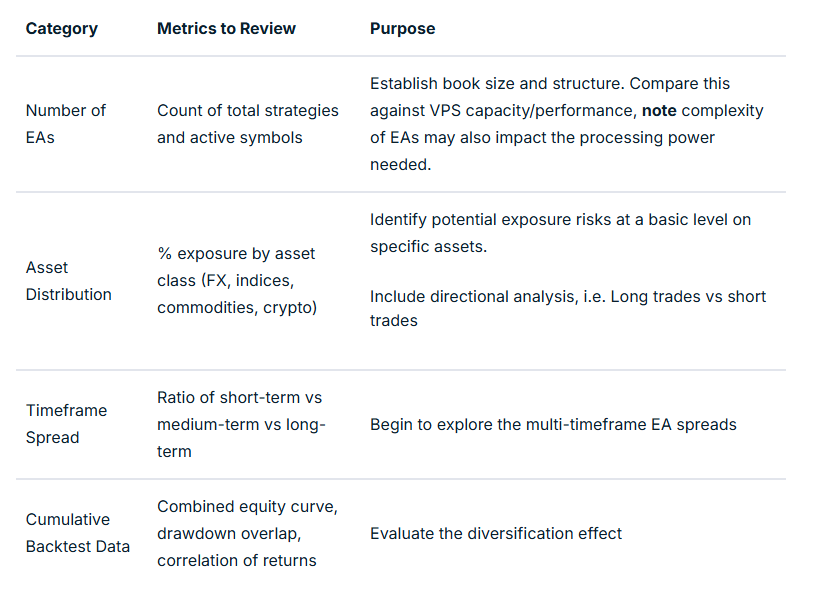
Temporal (timeframe) Balancing
When combined, a timeframe balance (even on the same model and instrument) can help flatten equity swings.
For example, a losing phase in a fast-acting M15 EA can often coincide with a profitable run in an H4 trend model.
Combining this with some market regime and sessional analysis can be beneficial.
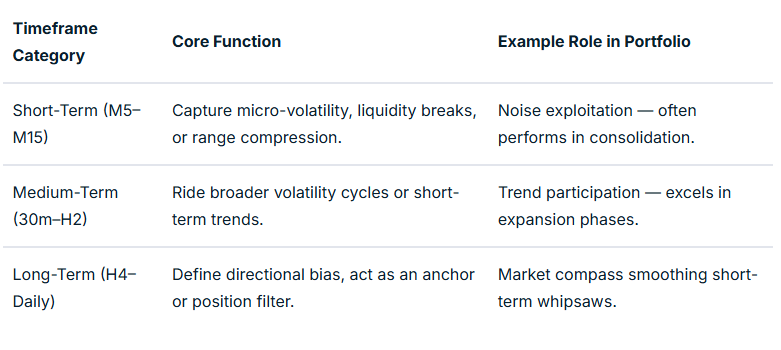
Asset Balance: Managing Systemic Correlation Risk
Running five different EAs on USDJPY might feel diversified if each uses different entry logic, even though they share the same systemic market driver.
But in an EA context, correlation measurement is not necessarily between prices, but between EA returns (equity changes) relating to specific strategies in specific market conditions.
Two EAs on the same symbol might use completely different logic and thus have near-zero correlation.
Conversely, two EAs on a different symbol may feel as though they should offer some balance, but if highly correlated in specific market conditions may not achieve your balancing aim.
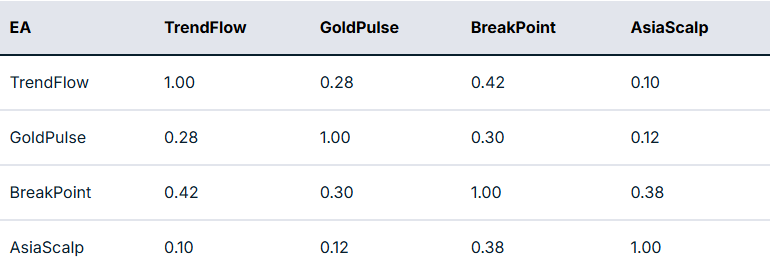
In practical terms, the next step is to take this measurement and map it to potential actionable interventions.
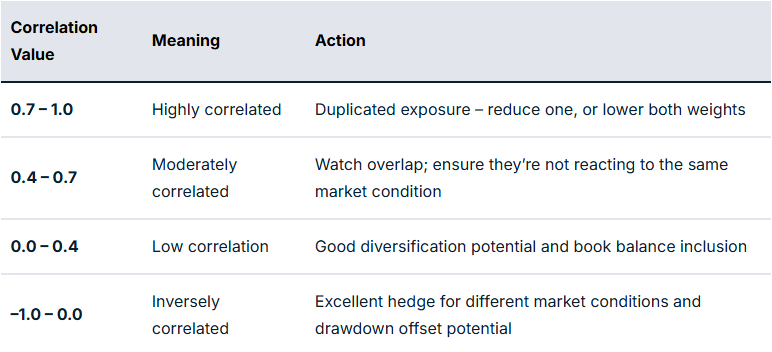
For example, if you have a EURUSD Trend EA and a GBPUSD Breakout EA with a correlation of 0.85, they are behaving like twins in performance related to specific market circumstances. And so you may want to limit exposure to some degree if you are finding that there are many relationships like this.
However, if your gold mean reversion EA correlates 0.25 compared to the rest of your book, this may offer some balance through reducing portfolio drawdown overlap.
Directional and Sentiment Balance
Markets are commonly described as risk-on or risk-off. This bias at any particular time is very likely to impact EA performance, dependent on how well balanced you are to deal with each scenario.
You may have heard the old market cliché of “up the staircase and down the elevator shaft” to describe how prices may move in alternative directions. It does appear that optimisation for each direction, rather than EAs that trade long and short, may offer better outcomes as two separate EAs rather than one catch-all.
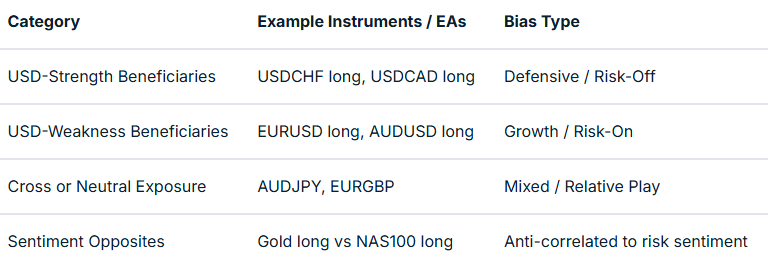
Market Regime and Volatility Balance
Trend and volatility states can have a profound impact on price action, whether as part of a discretionary or EA trading system. Much of this has a direct relationship to time of day, including the nature of individual sessions.
We have a market regime filter that incorporates trend and volatility factors in many EAs to account for this. This can be mapped and tested on a backtest and in a live environment to give evidence of strategy suitability for specific market conditions.
For example, mean reversion strategies may work well in the Asian session but less so in strongly trending markets and the higher volatility of the early part of the US session.
As part of balancing, you are asking questions as to whether you actually have EA strategies suited to different market regimes in place, or are you using these together to optimise book performance?
The table below summarises such an approach of regime vs market mapping:
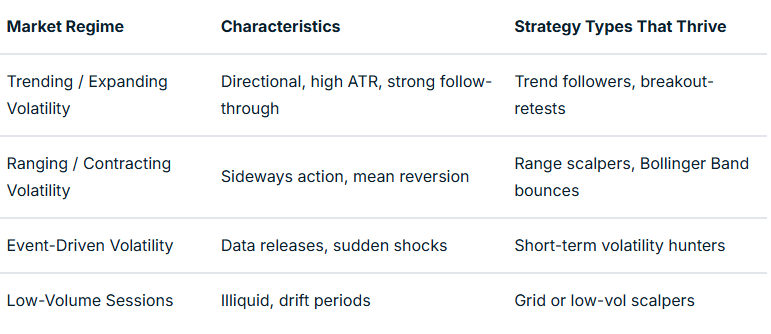
Multi-Level Analysis: From Composition to Interaction
Once your book is structured, the challenge is to turn it into something workable. An additional layer of refinement that turns theory and measurement into something meaningful in action is where any difference will be made.
This “closing the circle” is based on evidence and a true understanding of how your EAs are behaving together. It is the step that takes you to the point where automation can begin to move to the next level.
Mapping relationships with robust and detailed performance evaluation will take time to provide evidence that these are actually making a difference in meeting balancing aims.
To really excel, you should have systems in place that allow ongoing evaluation of the approaches you are using and advise of refinements that may improve things over time.
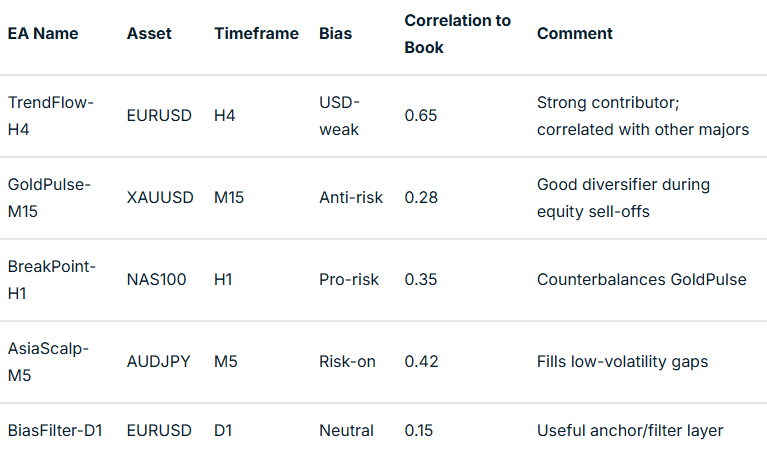
What Next? – Implementing Balance in Practice
Theory must ultimately translate into an executable EA book. A plan of action with landmarks to show progress and maintain motivation is crucial in this approach.
Defining classification tags, setting risk weights, and building monitoring dashboards are all worth consideration.
Advanced EA traders could also consider a supervisory ‘Sentinel’ EA, or ‘mothership’ approach, to enable or disable EAs dynamically based on underlying market metrics and external information integrated into EA coding decision-making.
Final Thoughts
A balanced EA portfolio is not generated by accident; it is well-thought-out, evidence-based and a continuously developing architecture. It is designed to offer improved risk management across your EA portfolio and improved trading outcomes.
Your process begins with mapping your existing strategies by number, asset, and timeframe, then expands into analysing correlations, directional bias, and volatility regimes.
When you reach the stage where one EA’s drawdown is another’s opportunity, you are no longer simply trading models but managing a system of EA systems. To finish, ask yourself the question, “Could this approach contribute to improved outcomes over time?”. If your answer is “yes,” then your mission is clear.
If you are interested in learning more about adding EAs to your trading toolbox, join the new GO EA Programme (coming soon) by contacting [email protected].


There are few trades as appealing, or as risky, as trying to catch a market reversal. The idea of entering at the turning point and riding the new trend is exciting. However, most traders fail to consistently produce good trading outcomes on this potential, often entering too early without confirmation, and thus get caught at a pause point of a continuing powerful move.Trend reversals can indeed offer excellent reward-to-risk potential, but as with any trading approach, only when approached systematically, the confluence of key factors, and timing.
What Is a High-Probability Entry?
Before diving into reversals specifically, let’s define what we mean by a high-probability entry.A high-probability entry is a trade taken in conditions where:
- There is clear evidence from price action and structure
- There is an alignment with the overall market context, such as timing, favourable price levels, and volatility
- Risk can be logically defined and limited to within your tolerable limits
- It may offer a favourable risk-to-reward profile (providing you execute following a pre-defined plan)
This approach should underpin all trading strategy development. And be consistently executed according to your defined rules, which must be constantly reviewed and refined based on trading evidence.
Reversal vs. Retracement: Know the Difference
Many traders confuse a retracement with a reversal, often with potentially costly consequences. It is ok to exit on a retracement and be ready to go again if there is a breach of the previous swing high. But this must be part of your plan, with a strategy for trend continuation in place. However, if your plan suggests that you DON’T want to exit on retracements, then the following table gives some guidance on what potential differences may be. RetracementReversalA temporary move against the trendA complete shift in directional controlPrice often continues in original directionPrice begins trending in the opposite directionHealthy part of a trend’s rhythmMarks the end of a trendTypically shallow, to a Fib/MA/structureOften deep, may break previous swing structureVolume often reduced after swing high if long or swing low if short.Volume often increased after swing high if long or visa versa.
Understanding Trend Exhaustion
Before any reversal occurs, the existing trend must show signs of exhaustion. This is the first phase of a potential turning point — and one of the most overlooked.
How Trend Exhaustion Looks on a Chart:
- Climactic candles – multiple wide-range bars with expanding bodies.
- Failed breakouts – price pushes through a level but fails to hold.
- Reduced momentum – smaller candles, overlapping wicks, indecision bars.
- Volume spikes with no follow-through – smart money distributing or exiting.
- Multiple tests of the same level – a sign that the trend is running out of energy.
The Anatomy of a High-Probability Reversal
A strong reversal setup typically has three key factors that can be supportive of a of follow-through.
1. Location – Price at a Key Zone
- Major support/resistance level honoured
- Prior swing highs or lows at a similar price point
- Higher timeframe structure – I,e, agreement on a 4 hourly chart as well as an hourly.
In simple terms, if the price isn’t at a meaningful location, a meaningful reversal is less likely to occur.
2. Previous Signs of Trend Exhaustion
We have covered this above, with evidence that the current trend has now weakened, and there is some justification to prepare to enter a counter-trend.
3. Structural Confirmation
This is the trading trigger you are looking for as a potential signal for entry. Structural confirmation transforms an idea (“the price might reverse”) into an actual setup (“the reversal is underway”).Look for the following four signs:
- Trendline or key short-term moving average breached
- Lower highs and lower lows in an uptrend or higher lows in a downtrend
- Confirmation that a key swing point has been honoured
- Evidence that a retest and rejection of the broken structure has occurred.
This shows that momentum has not just stalled, it has now shifted.
Context Filters
Reversals are more likely to succeed when conditions are supported by other factors. This is to do with the identification of a strong market context where reversals are more likely to happen. These may include:
- Time of day: The open of London or US sessions, or into session close when there may be some profit taking on a previously strong move
- Volatility extremes: Price has expanded beyond its normal daily range (ATR-based or visually evidenced on a chart)
- Market sentiment: Everyone is already long at the top or short at the bottom — setting up for a squeeze
- Catalysts: Reactions to news, or data, that may cause a significant one-sided move
Adding context could make the difference between a technically correct trade and one that may offer a higher probability of going in your desired direction.
Recognising Common Reversal Patterns
There are classic chart patterns that may help visually reinforce the principles. They reflect exhaustion, rejection, and structural change, and may encourage many traders to follow the move, adding extra momentum to any initial move. PatternSignal TypeKey ClueConfirmation NeededDouble Top/BottomReversal StructureRepeated rejection of key levelBreak of swing low/high between peaksHead & ShouldersMomentum FailureFailed retest after strong pushNeckline breakPin BarExhaustion CandleSharp rejection with long wickOpposite-direction close after the pinEngulfingSudden Power ShiftOne candle overtakes previous rangeFollow-through candleRounding Top/BottomSlow Institutional TurnGradual stalling and reversalNeckline break of curveBreak of Structure (BoS)Structural ConfirmationNew higher low/lower high, support breakRetest and failure to reclaim broken level⚠️ These patterns should not be traded in isolation. Use them with context and only after signs of exhaustion and structure shifts.
FOUR Trader Reversal Traps to Avoid
Even with a solid framework, it’s easy to fall into common traps:
- Trying to pick the exact top or bottom - Wait for price to prove the turn, don’t anticipate and enter early
- Entering against the higher timeframe trend – Zooming out and checking alignment with higher timeframes may be prudent to reduce the likelihood of having to fight momentum on larger timeframes.
- Trading every reversal signal - Not all signals are valid or particularly strong. Look for the confluence of multiple factors covered earlier, not just the presence of a pattern.
- Letting bias override evidence - Just because you want a reversal to happen, it NEVER means it is there unless backed up by evidence.
Don’t Forget the Full Trading Story
A great setup means nothing without excellent execution. These ESSENTIAL facts are critical as with any trade, but there will never be an apology for reinforcing these.
Patience and execution discipline
Wait for your full criteria to be met. Avoid “almost” setups that feel tempting but don’t fully align with your full plan criteria. Likewise, when all your boxes are ticked, then take action.
Exit strategy
Use a mix of targets, structure-based trails, or scaling out, and know in advance how you’ll manage the trade once it starts moving.High-probability entries are only one part of a winning trade. Exit efficiently or you’ll waste great entry setups because of poor execution. There are many traders in this position; make sure you are not one of them.
Summary
High-probability reversals are not about being right at the top or bottom when you enter; this is rarely possible and adds additional risk without confirmation. They are about recognising and being ready when the trend is potentially changing, and taking action when:
- Price is at a key level
- The current trend shows clear signs of exhaustion
- Structure confirms the shift
- And context supports the move
Trade the evidence and your plan, not just what you think is likely to happen. Be patient, be ready, and when the setup is there, execute your trade with confidence.


Every serious trader has “had a go” at scalping at some point in their journey. The idea of rapid and high-frequency entries, quick profits, with dozens of trades in a single session, suggests that it is a fast path to achieving a potential income from trading. The theory is that if you can make just a few pips or points repeatedly and frequently, the results should compound quickly and on a sustainable basis. However, stories of multiple account blow-ups and trader burnouts as the effort in a higher stress situation takes its toll bring up justifiable questions as to whether this “good on paper” theory can translate into real-world trading success.
What Is Scalping?
Scalping involves placing a high volume of very short-term trades, aiming to capture small price movements with trades that are opened and closed within minutes or even seconds of entry. Scalpers rely on precision in action, timing, and tight cost control, rather than letting trades breathe or evolve into longer moves, as you see in other types of trading approaches.Scalping is commonly used in markets with the highest liquidity, where the spread is at its tightest.For example:
- Forex majors (e.g., EUR/USD, GBP/USD)
- Index futures (e.g., NASDAQ, DAX, FTSE)
- Commodities like gold (though spread and volatility can be a challenge)
How Does Scalping Work?
Traders using a scalping approach are looking for small inefficiencies or bursts of movement they can exploit repeatedly as sentiment shifts.Three common types of scalping techniques include: momentum scalping, mean reversion, and order flow scalping. The first two of these can be used on CFDs on Metatrader platforms. The latter is more common in futures markets.
Momentum Scalping
This approach involves looking for and jumping on breakouts or price surges as price momentum begins to build, with an exit quickly before price begins to pause. This is most commonly used at session opens or news events when the volume of traders is high and repositioning of trader positions may be at its highest. Faster timeframes are usually used, e.g., 1-minute candles, when there appears to be a brief but technically identifiable sentiment change.
Range-Bound / Mean Reversion Scalping
Mean reversion strategies are based on the principle that prices regularly trade in a range, often while market participants are waiting for the next piece of news or technical breach of either the top or bottom of that range. During this time, as the range high and low are tested, it is common that the price will return to the mean of that range after each unsuccessful test. Scalpers will attempt to identify these micro-ranges and short a test to the upper end or go long with tests of the bottom end. This can work best in the quieter part of sessions or during consolidation periods, with a breach of the defined support/resistance used as a relatively obvious risk management level.
Key Principles of a Successful Scalping Strategy
Execution Speed
Fast and reliable execution is critical to optimise scalping strategies. Slippage, delayed fills, and lower liquidity with wider spreads can eat into profits significantly in these strategies, where the profit target is often just a few pips. Scalpers may use dedicated VPS servers where latency is less and, when there is evidence that a strategy may be working, may attempt to create EAs that execute the criteria for entry and exit automatically to maximise the time your strategy is working on the market (i.e. it is doing this even when you are not in front of a screen).
Low Spread and Commission
Spread becomes an essential component of your profit potential, more so than with any other strategy. If you are aiming for 3–5 pips of profit and the spread takes most of this away, your market battle becomes even harder than it already is. Even a small difference in transaction costs can erode a scalper’s profitability significantly over hundreds of trades. GO Markets offers very competitive spreads as well as other options for spread traders to help you find the best solution for you.
Clear, Repeatable Entry Rules
Because scalping relies on speed and repetition, there is no room for ambiguity or options in any part of your trading rules for action. Entry criteria must be specific, precise, and must be actioned without hesitation once the defined action price hits your trigger level. What you use as these action points is irrelevant in this context, be it candle closes or tick movement, the rules need to be black-and-white and actioned accordingly.
Tight Risk Control
Risk management is important in any trading context, and in scalping, this is no different. Stops can be just a few pips or points away, and a single large loss due to second-guessing or not following the plan can easily and quickly undo gains from several winning trades. Having referenced the absolute necessity for specific and unambiguous criteria for entry, this is no less vital for exit if you are to achieve your target win rate, desired average won-loss, and maximum acceptable drawdown.
Time-Bound Trading
Scalping strategies, by their nature, are usually mentally intense with concentration levels critical when trading. Management of this should be front and centre of your time plan when you are trading. You should set clear, pre-determined, and non-negotiable start and end times, limiting the amount of time to maintain an optimum trading state and reduce the likelihood of errors in decision making. For example, if your scalping plan is best actioned on session opens, limit your time to these, then walk away.
Risks and Pitfalls of Scalping
While scalping can be successful if you adopt the key principles above, it’s also very easy to fall short of what is required to achieve success on an ongoing basis. Rigidly adhering to what is needed is something to constantly remind yourself of, as there are common key challenges that have the ability to derail the trader (and they often do).
Overtrading
Scalping may lead to ‘compulsive’ overtrading. The “thrill of the chase” created by the high intensity of this trading style can tempt traders to push past their planned trade limits, stray from the strict criteria for entry, as they try to force more trades. These rarely create positive trading outcomes.
Spread and Slippage
You need to become a measurement guru, watching key trading metrics on an ongoing basis, including the impact of cost,s is critical as previously stated. Widening spreads can be massively impactful on profit potential, and some would have a maximum spread as part of the entry criteria because of this. This can and should be reviewed during your trading activity and as part of your trading business ritual.
Psychological Strain
Scalping is high-pressure and “fast” decision-making and action-taking. This pace is not for every trader, and you must monitor both your behaviour and performance during trading, adhering to and reviewing the boundaries you have set, but also be honest with yourself to look at something else if this is just simply not a “fit” for you.
The Case for Automation?
Many scalpers explore the use of EAs for the automation of their tested scalping strategies. Of course, this will eliminate some of the critical challenges by taking away the immediate “in front of chart” stress.There is also a strong case that this will help in “not missing” trades through an inability to watch markets for 24 hours.Don't be fooled, though; this is not a shortcut. The same rigour in terms of creation, testing, and ongoing monitoring with refinement remains. It is not saving work — as much work is still required if you are to achieve any success. It is using a tool to provide more execution certainty. It is perhaps worth considering once you have a strategy that shows promise and ticks all of the boxes for the scalping strategy criteria.
A Simple Momentum Scalping Strategy (Example)
Here is an example of a very basic framework for a 1-minute momentum scalping setup on EUR/USD. *Note: This is merely an example of how scalpers may structure a scalping plan:Market: EUR/USDTimeframe: 1 MinuteSession: First 60 minutes of London OpenSetup Logic:
- Identify when price breaks a 5-bar high with momentum
- Volume increase from previous bar
- Look for a strong bullish candle (body >70% of range)
- Ensure spread is below 0.4 pips
Entry:
- Buy at breakout +2 pips on 1 minute bar close
Exit:
- Use a hard stop of 2 pips from entry signal
- Target 6 pips profit
- Trail stops to breakeven on a 3 pip move
Risk Notes:
- No more than 6 trades in a session to maintain focus
- Cap trading session time to 60 minutes.
Final Thoughts
Despite the attractive and exciting high-intensity battle of trader versus market, scalping is not a shortcut or a casual strategy. It’s a high-performance, rigid approach that requires great preparation, clarity of planning and action, reaction speed, and precision in execution. Take a step-by-step approach; it may be for you (and don’t be shy of walking away if you discover it is not). You need to put in the “hard yards” at the front end if you want to see trading rewards from scalping.


Despite living through one of the most chaotic political and trade environments in recent history, the ASX 200 delivered its strongest performance since the pandemic rally.The S&P/ASX 200 Index gained 9.97% in capital growth and 13.81% in total returns, hitting a record high of 8,639.1 points in June.While Trump's tariff announcements caused dramatic market swings — including the ASX plunging nearly 500 points on "Liberation Day" — Australian markets weathered the storm and managed to rally before the financial year end.The rally was driven primarily by heavyweight banks like Commonwealth Bank and Westpac, with CBA alone responsible for nearly half the index's gains.However, the performance was not uniform across all sectors — five of the 11 ASX market sectors actually lost value during the financial year.
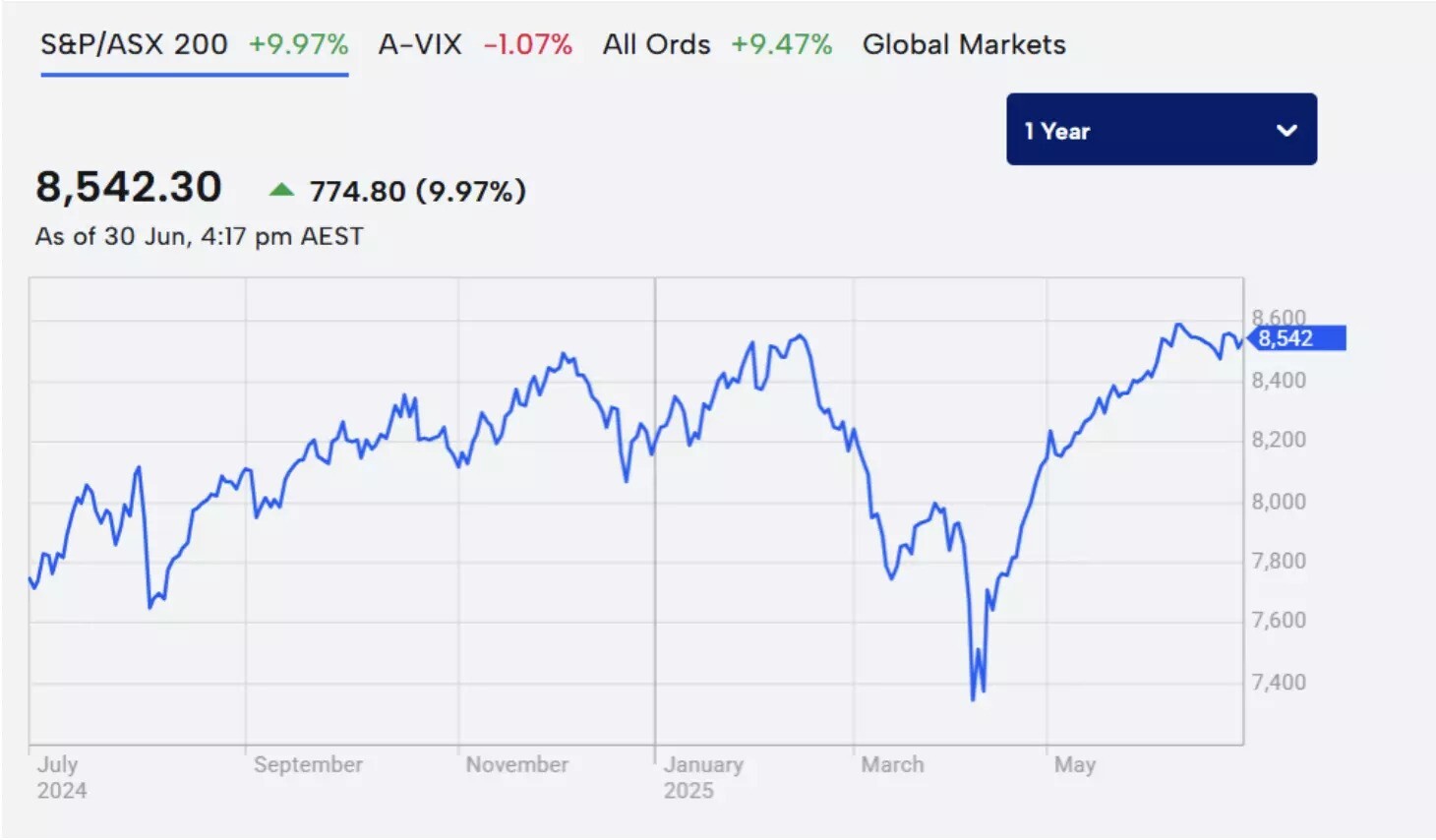
Sector Performance Rankings
Financials
The ASX 200 financials sector was the top-performing market sector of FY25, with the Financials Index rising by 24.45% and delivering total returns including dividends of 29.39%.Sector Champion: Despite Commonwealth Bank's headline-grabbing 45% rise that captured most investor attention, it was retirement and general investment solutions provider, Generation Development Group (ASX: GDG), that led the sector with a rise of 114% in FY25.
Technology - AI Boom Continues
The Information Technology Index rose by 23.89% and provided a total return of 24.19%.Sector Champion: TechnologyOne outperformed both its FY24 and 1H25 earnings expectations — 9.8% and 11.3% on each result respectively. ASX:TNE rose 121% during FY25 to close at $41.01.
Communications
The Communications Index gained 23.4% for the year.Sector Champion:EVT topped the communication leaderboard in FY25. The stock has largely traded nowhere since 2015, but found some momentum thanks to a bump in earnings from its cinema business, with the stock rising 41%.
Industrials
The Industrials Index gained 22% during FY25.Sector Champion: Qantas Airways (ASX:QAN) shares rose 84% to close at $10.74. Lower jet fuel prices, strong international and domestic pricing, and capacity growth gave investors renewed confidence in the leading Australian airline.
Consumer Discretionary
The Consumer Discretionary Index rose 18% for the year.Sector Champion: Temple & Webster Group (ASX:TPW) dominated the sector with a 127% gain to $21.32. Improved consumer sentiment and strong sales saw the e-commerce furniture company capitalise on momentum, especially in its home improvement and B2B categories.
Real Estate & REITs
The Real Estate Index gained 10% despite volatile bond yields throughout the year.Sector Champion: Charter Hall Group (ASX:CHC) was the sector leader — closing the financial year 72% higher at $19.19 per share.[caption id="attachment_712086" align="alignnone" width="1101"]
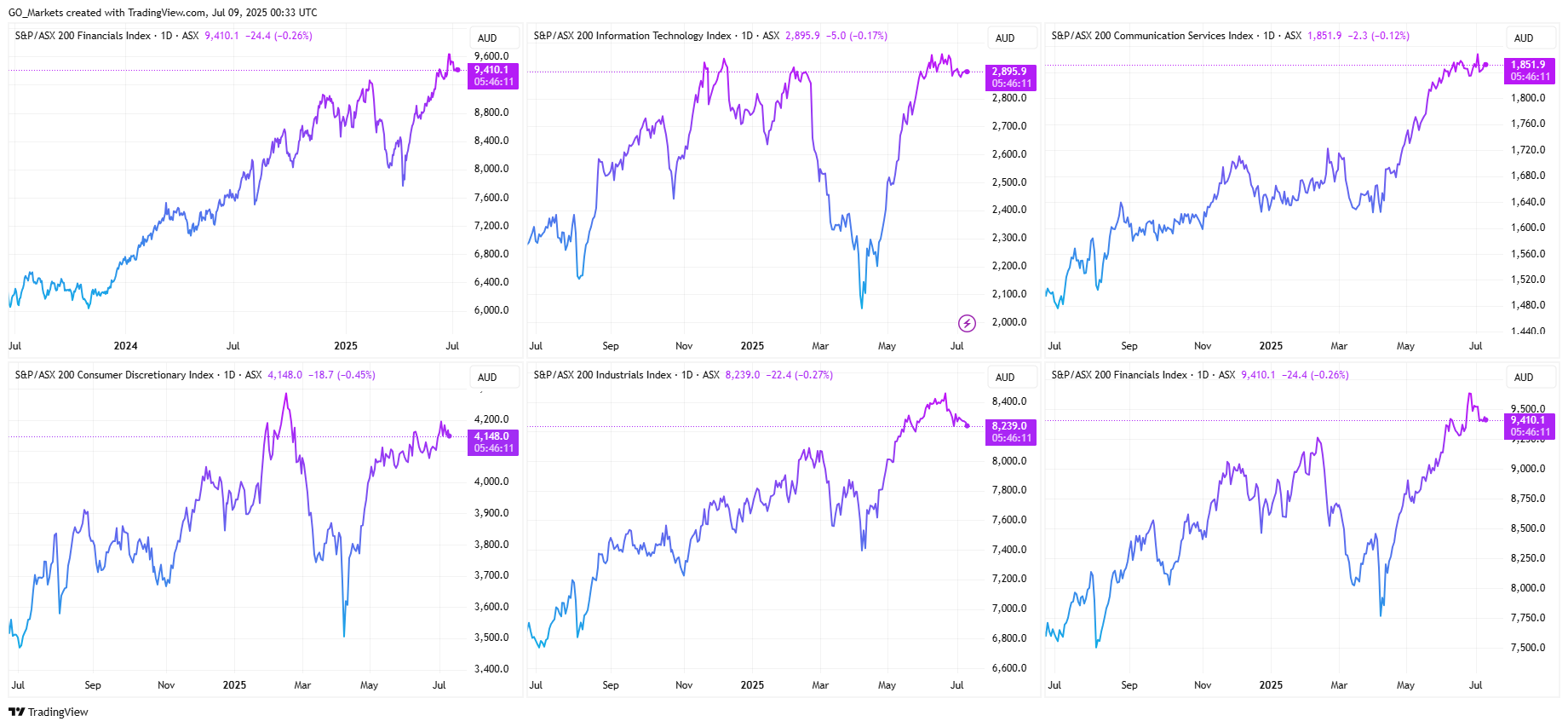
Top-performing sectors in FY25[/caption]
Utilities
The Utilities Index fell 1.6%.Sector Champion: APA Group (ASX:APA) managed a modest 2.3% gain in FY25, but managed to come out above its peers as the sector's best performer.
Consumer Staples
The Consumer Staples Index declined 2.1%.Sector Champion: Bega Cheese (ASX:BGA) led the sector with a 28% gain, backing up its strong FY24 results.
Healthcare
The Healthcare Index fell 5.99% despite some individual standouts.Sector Champion: Sigma Healthcare's merger with Chemist Warehouse created one of the biggest rallies of the year. As the merger gained clarity, the stock's potential inclusion in the S&P/ASX 200 drove strong buying from investors. Sigma (ASX:SIG) gained 135% to close at $2.99.
Materials
The second-worst sector was materials, with the Materials Index dropping 6.04%. Sector Champion: Despite sector struggles, gold miner Regis Resources (ASX:RRL) ascended 150% to close at $4.39, benefiting from rising gold prices.
Energy - The Year's Biggest Loser
The worst-performing ASX sector was energy, with the Energy Index falling 13.52%. Influences largely by the sector's largest stock — Woodside Energy Group — crumbling by 16%, closing at $23.66. Sector Champion: Uranium explorer Deep Yellow (ASX:DYL) stood out in the struggling sector with a 25% gain.[caption id="attachment_712087" align="alignleft" width="1051"]
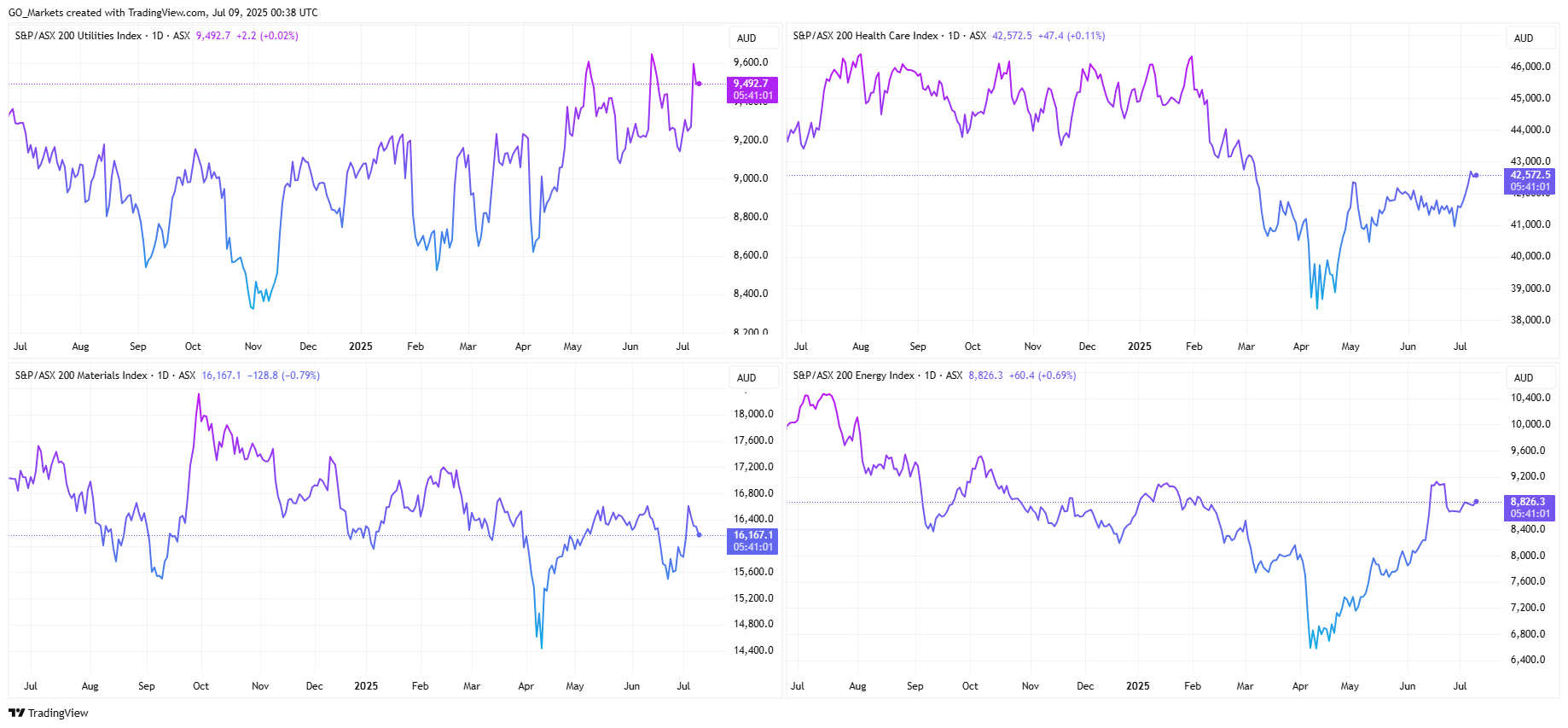
Worst-performing sectors in FY25[/caption]
Looking Ahead
The results of FY25 tell a simple story: execution matters more than sector. Technology and financials thrived because the best companies in these sectors did what they said they would do. Energy and materials struggled because many companies in these sectors are fighting structural headwinds, not just cyclical ones. The market is becoming more about which companies to back, rather than which sectors to back. Looking forward to FY26, this pattern could become even more pronounced as geopolitical tensions and trade wars see market uncertainty become the norm rather than the exception.


The ASX 200 closed out the 2025 financial year on a high, reaching a new intra-month peak of 8,592 in June and within touching distance of the all-time record. The index delivered a 1.4% total return for the month, rounding off a strong final quarter with a 9.5% return and locking in a full-year gain of 13.8% — its best performance since 2021.This strong finish all came down to the postponement of the Liberation Day tariffs. From the April 7 lows through to the end of the financial year, the ASX followed the rest of the world. Mid-cap stocks were the standout performers, beating both large and small caps as investors sought growth opportunities away from the extremes of the market. Among the sectors, Industrials outperformed Resources, benefiting from more stable earnings and supportive macroeconomic trends tied to infrastructure and logistics.But the clear winner was Financials, which contributed an incredible 921 basis points to the overall index return. CBA was clearly the leader here, dominating everything with 457 basis points on its own. Westpac, NAB, and others also played a role, but nothing even remotely close to CBA. The Industrials and Consumer Discretionary sectors made meaningful contributions, adding 176 and 153 basis points, respectively. While Materials, Healthcare, and Energy all lagged, each detracting around 45 to 49 basis points. Looking at the final quarter of the financial year, Financials were by far the biggest player again, adding 524 basis points — more than half the quarter’s total return of 9.5%. Apart from a slight drag from the Materials sector, all other parts of the market made positive contributions. Real Estate, Technology, and Consumer Discretionary followed behind as key drivers. Once again, CBA was the largest individual contributor, adding 243 basis points in the quarter, while NAB, WBC, and Macquarie Group added a combined 384 basis points. On the other side of the ledger, key underperformers included BHP, CSL, Rio Tinto, Treasury Wine Estates, and IDP Education, which all weighed on quarterly performance.One of the most defining features of the 2025 financial year was the dominance of price momentum as a market driver — something we as traders must be aware of. Momentum strategies far outpaced more traditional, fundamental-based approaches such as Growth, Value, and Quality. The most effective signal was a nine-month momentum measure (less the most recent month), which delivered a 31.2% long-short return. The more commonly used 12-month price momentum factor was also highly effective, returning 23.6%. By contrast, short-term reversals buying last month’s losers and selling last month’s winners was the worst-performing approach, with a negative 16.4% return. Compared to the rest of the world, the Australian market was one of the strongest trades for momentum globally, well ahead of both the US and Europe, despite its relatively slow overall performance.Note: these strategies are prone to reversal, and in the early days of the new financial year, there has been a notable shift away from momentum-based trading to other areas. Now is probably too early to say whether this marks a sustained change, but it cannot be ignored, and caution is always advised.The second big story of FY26 will be CBA. CBA’s growing influence was a key story of FY25. Its weight in the index rose by an average of 2.1 percentage points across the year, reaching an average of 11.5% by June. That helped push the spread between the Financials and Resources sectors to 15.8 percentage points — the widest gap since 2018. Despite the strong cash returns, market valuations are eye-watering; at one point during June, CBA became the world’s most expensive bank on price metrics. The forward price-to-earnings multiple now sits at 18.9 times. This is well above the long-term average of 14.7 and higher than the 10-year benchmark of 16.1. Meanwhile, the dividend yield has slipped to 3.4%, down from the historical average of 4.4%. Earnings momentum remains soft, with FY25 growth estimates still tracking at 1.4%, and FY26 forecast at a moderate 5.4%. This suggests that recent gains have come more from expanding valuation multiples than from actual earnings upgrades, making the August reporting date a catalyst day for it and, by its size, the market as a whole.On the macro front, attention now turns to the Reserve Bank of Australia. The central bank cut the cash rate by 25 basis points to 3.6% at its July meeting. Recent commentary from the RBA has taken on a more dovish tone, with benign inflation data and ongoing global uncertainty expected to outweigh the strength of the labour market. The RBA appears to be steering toward a neutral policy stance, and markets will be watching for further signals on how that shift will be managed. Recent economic data has been mixed. May retail sales were weaker than expected, while broader household spending indicators held up slightly better. Building approvals saw a smaller-than-hoped-for bounce, employment remains strong, but productivity is low. Inflation is now at a 3-year low and falling; all this points to underlying support from the RBA’s easing bias both now and into the first half of FY26.As we move into FY26, the key questions are:
- Can fundamentals wrestle back control over momentum?
- Will earnings growth catch up to price to justify valuations?
- How will policy decisions from the RBA and other central banks shape investor sentiment in an ever-volatile world?
While the early signs suggest a possible rotation, the jury is still out on whether this marks a new phase for the Australian market or just a brief pause in the rally that defined FY25.


In the world of trading, few stories are as famous as the one behind the Turtle Traders. The Turtle experiment was simple in concept — could absolute beginners, given nothing but a set of rules and two weeks of training, beat the markets?The results of the experiment were extraordinary. Even today, four decades later, many of their principles still echo through our algorithm-dominated trading world.In this article, we’ll revisit the original Turtle strategy, examine how it worked, and explore how this legendary approach could be reimagined for modern traders.
Who Were the Turtles?
The Turtle Traders were the product of a famous bet between trading legend Richard Dennis and his partner William Eckhardt. Dennis believed that trading could be taught; Eckhardt thought that the ability to trade was a set of skills that you are born with. To settle the debate, Dennis placed an ad in the newspaper and selected a group of everyday individuals, none of whom had any prior trading experience.These recruits underwent a two-week crash course in trading, during which they were taught a complete, mechanical system. It was based on trend-following logic, relying on breakouts, strict entry and exit rules, and position sizing based on market volatility. The idea was simple — eliminate emotion, follow the rules, and let the trends do the work.The experiment was a runaway success. As a group, the Turtles reportedly achieved an average annual return of 80%, managing millions in capital and building one of the most talked-about trading systems in history.
Turtle Trading Rules and Instruments
Entry Rules:
The Turtles followed mechanical entry rules based on the concept of trading with the trend. The initial entry criteria were:
- Enter a long position if the price breaks above the 20-day high.
- Enter a short position if the price falls below the 20-day low.
- For a more conservative approach, a second strategy of a 55-day breakout was used as an alternative.
- Orders were placed using buy/sell stop orders triggered by the breakout.
Markets Traded:
The system was applied across a wide range of liquid futures markets:
- Currency Futures: EUR/USD, JPY/USD, GBP/USD, CHF/USD, CAD/USD
- Commodity Futures: Gold, Silver, Crude Oil, Heating Oil, Corn, Wheat, Soybeans, Sugar, Cocoa, Cotton
- Stock Index Futures: S&P 500, Nikkei 225, Dow Jones (DJIA)
- Interest Rate Futures: U.S. Treasury Bonds, Eurodollars
The Importance of Volatility:
They used the Average True Range (ATR) of a 20-days, termed “N”, in many of their calculations to account for the impact of volatility.
Pyramiding (accumulation): Adding to Winning Trades:
The Turtles were also taught to scale into winning trades. This method, known as pyramiding or accumulation, involved adding to a trade if the price moved in their favour. If N (ATR) was 40 points, they would add 0.5 × the Average True Range to the trade. For example, accumulation of a new position would be actioned at 20 and then again at another 20, adding up to a maximum of four positions: the original trade plus three additional entries.
Exits and Risk Management
Initial Stop Loss:
Each trade was initiated with a stop loss placed 2N away from the entry price. This ensured that no single trade risked more than 2% of the account balance.
Trailing Stop:
As the trade progressed and additional units were added, the stop loss was dynamically adjusted using the most recent entry as a reference.The trailing stop for all positions was 2N on the latest (most recent) added position. If the stop was hit, all positions in that trade were closed simultaneously, locking in gains and controlling downside risk.
How Have Markets Changed Since the 1980s?
- Algorithmic and high-frequency trading (HFT) now dominate markets, often resulting in faster and more erratic price movements.
- Trading costs (commissions, spreads) have significantly decreased, enabling more frequent entries and tighter stops.
- Trend persistence has diminished. Markets often reverse more quickly, making it harder for long-trend strategies to succeed without adaptation.
- Forex and futures markets are more liquid, making it easier to execute large positions with less slippage.
- Futures markets have seen changes in volume and type, enabling a greater selection of asset choices.
- Stock indices tend to exhibit more mean reversion, demanding smarter trend filters.
- Breakouts from common levels are less reliable, often resulting in quick reversals due to stop hunting and market manipulation.
- A greater need for confirmation signals before acting on a breakout.
- ATR-based sizing remains relevant but may benefit from more dynamic scaling.
- Rigid stop-loss rules (like 2× ATR) are more likely to be hit due to shorter trend durations.
How Could the Turtle System Be Used Today?
Although the principles underpinning the turtle systems remain valid for trading today, some tweaking of the original criteria and parameter levels would be worth exploring.
Entry Modifications:
Requiring confirmation from trend filters, such as price being above the 200 EMA or RSI values above 55, or perhaps looking for confirmation on larger timeframes, could reduce false signals and improve win rates.Additional volume filters, including relative volume, OBV, and average volume, may add value to decision-makingIncorporating indicators developed since the turtle experiment, such as other variations of the ATR and RSI, Bollinger bands, and Keltner channels, may be worth consideration for the confluence of the basic trend following structure.
Exit and Risk Enhancements:
In the turtles experiment, the ATR was static once the initial trade was entered; the N value remained fixed for that position and all subsequent accumulated positions. Arguably a dynamic ATR instead of a fixed level may be worth consideration to adjust to changing volatility over time.This especially makes sense if you are considering adding additional confluence from other indicators for the initial position.
Trade Like a Turtle
Using the original Turtle approach could be considered a checklist for good practice. Especially when it comes to rule-based system designs, risk management, emotional discipline in execution, and equal attention to entry, accumulation, and exit.Consider testing a “Turtle-inspired” strategy using current instruments and enhanced filters before taking it live. The spirit of the Turtle experiment lives on not just in its rules, but in the key message that trading can be taught. You can learn it, but success depends on sticking to a well-thought-out plan and adhering to the golden rules of trading that still apply today.


Most traders obsess over entries, indicators, and setups, but often overlook a simple factor — the time of day that you trade.Time of day affects volatility, liquidity, and when new information enters the market. Ignoring it can turn good setups into frustrating inactivity, or even losses, while embracing it can help you trade with the market, not just the setup.
Why Time of Day Is Important
Markets are not equally active during the whole period they are open. Price action is driven by human behaviour, either on an individual or organisational level. Behaviour commonly follows routines:
- Economic data is released at scheduled times
- Institutions trading during business hours
- Retail traders are more active during specific sessions — in terms of volume and location.
This invariably creates rhythms in the market. By learning to trade with these rhythms, your trades will often require less confirmation, you improve stop placement, and have cleaner follow-through on trading ideas.
The Global Trading Clock
The trading day is broadly broken into three main sessions: Asia, Europe, and the US. Each has its own “character,” and benefits vary based on which time zone best aligns with your strategy.
1. Asia (Tokyo)
10pm –7am GMT: Markets are generally quieter except JPY and AUD FX pairs and index CFDs. Common characteristics include:
- Lower liquidity
- Range-bound behaviour
- Risk of false breakouts
Reversion strategies may do well in such market conditions as well as setting up highs and lows, which may be useful references for sessions later in the day.
2. Europe (London)
7am–4pm GMT: Increased volatility and volume are seen during the European session across many asset classes. The opening of the LME can influence metals prices, and US futures may respond accordingly to increased volatility. Common characteristics include:
- Large institutional flows
- Strong trends can begin
- Overlaps with NY for 2 hours
Breakout strategies using Asian session highs or lows as reference (or previous days' US session) may outperform. And trend continuation and reversal approaches on the back of new data coming out of Europe may also be common. The two-hour crossover with the subsequent US session can also be an important change in market conditions.
3. US (New York)
12pm–9pm GMT: Volatility spikes may occur at US equity market open and significant data releases with global asset class impact are often released at 8.30am US Eastern time. Common characteristics include:
- Major economic releases
- US equity open creates short-term momentum
- Slower into the late session
Fast moves might be prevalent early in the day, suggesting short-term momentum-supported new trend set-ups may outperform. Reversals around the middle of the day are also not uncommon.The Federal Reserve interest rate decisions are always in the early afternoon in the US, which can flip market sentiment.
The Intra-Session Rhythm
It is not only session-to-session changes that can often be seen on price charts. Within each session, price often has a tendency to move in waves. So, as a general rule, you may see:
- Early session: bursts of volatility and institutional positioning
- Mid-session: consolidation or retracements
- Late session: thinning liquidity, profit-taking, fakeouts
Why Most Traders Miss This
During strategy development, many strategies are tested on charts without considering what time the setup occurred.A 15-minute candle during the London open isn’t the same as one during the Australian lunch break.So, if you start taking breakouts in low-volume periods, trading reversals just before news, or entering trends during midday doldrums, these may have less chance of meeting the goals for that particular trade.
How to Use Time of Day as a Filter Practically
1. Mark Your Session Windows
On your chart, visually block out the London open, NY open, and overlap. Use vertical lines or shading — this will help you historically see what happens at these key times.*Note: We are developing a free indicator for this that you can place on a chart. Email [email protected] if you are interested.
2. Backtest by Session
You can split potential trades by session ‘time blocks’ that look back over time. Strategy types often work better during specific hours:
- Breakouts work 7am–10am GMT
- Mean reversion thrives 2am–5am GMT
- Reversals occur more often post-3pm GMT
Using your existing setups (or even previous trades), look at a sample to see what may have happened. 3. Add Time as a Trade FilterOnce you have some evidence from, test out simple rules like:
- “Only take trend trades between 7am–11am GMT”
- “No breakout entries after 3pm NY”
If you can code (or have access to someone who can), then you can backtest this quickly to see the impact of these filters.
4. Know the News Calendar
Most high-impact data is released at predictable times — make knowing what is happening and when part of your daily trending agenda. These contribute to the characteristics of a session, but also may flip what is standard on its head. Reference in your plan the major data points and how you are going to manage potential entry setups.
Trade With the Market — Not Just the Setup
The best trades don’t just have good structure; they also happen at the right time.Logically, if you want cleaner trade setups, high-probability entries, and improved consistency, then aligning your trading strategies with the market clock makes sense.It’s a simple shift that most traders ignore — perhaps to their detriment. Finding the best time of day to trade for your trading strategy could be one of the things that helps develop your trading edge.

